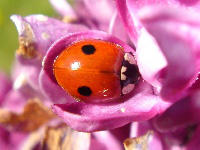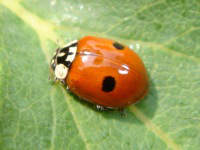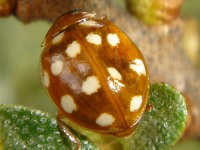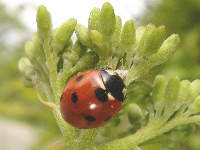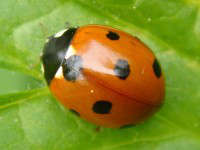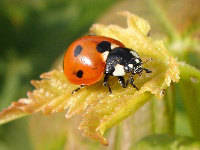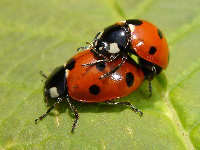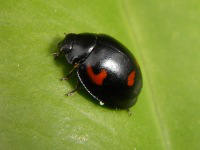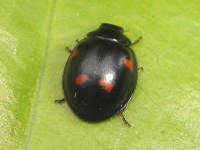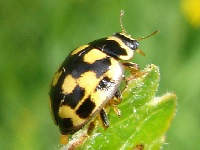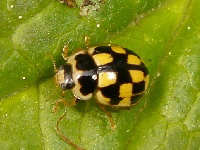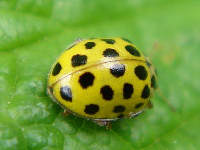(Category Beetles)
Coccinellidae is the name of the family of the ladybugs (also calles ladybirds) represented in Europe with 88 species. Ladybugs are usually distinguished by color and the number of spots on the wing case. The most common beetle of this family is the "Sevenspotted Lady Beetle" (Coccinella septempunctata, see the pictures above) whose coloration is very constant. It has a red base color with seven black spots on the wing case.
The species Adalia bipunctata (Twospotted Ladybug) on the other hand has a very variable coloration: The normal coloration is a red base color with two (Bipunctata) black spots, but there are two "inverted" variations with black base color and either four or six spots (see the pictures above of Adalia bipunctata). Although they don't have the same number of spots they still belong to the same species. The red variant is more likely to survive the winter whereas the black variant is capable of propagating itself faster than the red variant. This results in more red variants (and less black variants) in the spring and more black variants (and less red variants) in the fall.
Note that the number of spots does not indicate the age of a ladybird! Ladybugs usually only become one year old.
The coloring of many ladybug serves as deterrent for predators and points out that ladybugs can secrete a yellow liquid that smells and taste disgusting (see the first picture of Coccinella septempunctata).
Many ladybird species are carnivorous and devour numerous plant lice in their lives (as larva and as adult beetle).
But there are also species that are herbivorous such as "Thea vigintiduopunctata" (see the picture above) which eat mildew.
The fact that many ladybugs eat agricultural pests has made them to one of the most polpular and favoured beetle families in the world.
Frequently asked Questions about Ladybugs/Ladybirds (Facts on Ladybugs)
(Note: Some questions are redundant to the upper part. The FAQ was created to easily find what you are looking for)
How many legs do ladybugs have?
Ladybugs (adult beetles and larvae) always have six legs. As a matter of fact it is typical for all insects to have three leg pairs. Common insects are for example beetles, grasshoppers, dragonflies, wasps, bees, mosquitos, flies, true bugs, butterflies and many more.
How many spots do ladybugs have?
The number of spots depends on the ladybug species. There are many species on this globe and often different species have a different number of spots. There are however species that have the same number of spots as other species. The number of spots therefore is an easy way to distinguish certain species but not very reliable. Experts rely on other characteristics to fully identify a ladybug. Also it is worth mentioning that some species do not have any spots at all!
Why do ladybugs have spots?
There is no obvious reason *why* ladybugs have spots. It was probably just chance. Some ladybugs (Coccinelidae) do not even have spots at all!
Does the number of spots indicate the age of ladybirds?
Short answer: No.
Long answer: After pupating (similar to a caterpillar transforming to a butterfly) the adult beetle emerges out of the pupa. In a matter of days to hours the exoskeleton hardens and the appearance of the beetle is fixated (including the spots). After this point the beetle’s looks do not change anymore. So getting older does not add spots to the beetle’s wing case.
Fun fact: after hardening of the body the beetle isn’t even able to grow anymore. The size of the adult beetle depends on how well nourished the larva was before pupation.
Ladybugs usually only become one year old.
I found a ladybug. What species is it?
Have a look at the pictures below; maybe you can identify your ladybug :)
How does a ladybug larva look like?
The larva does not look anything like the adult beetle. Beetles (ladybugs) are holometabolic which means they undergo a complete metamorphosis similar to that of a butterfly. Depending on the species the larvae can look quite different but generally they have a black base color with splashes or stripes of yellow or red color. The Larvae have an elongated body shape with the legs attached in the upper half. Here’s a picture of larva:
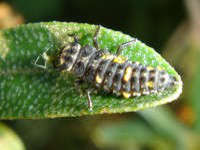
What do ladybirds eat? Do ladybugs feed on aphids?
It is a misbelieve that *all* ladybugs feed on aphids (plant lice). Not all do, but there are quite a lot of different species in Europe and the U.S. that do. These carnivorous ladybugs sometimes also eat other kinds of small insects. Some ladybugs however are vegetarians and eat mildew for example.
It is fall/winter time and I found a bunch of dead ladybugs in my attic/shed. Some are still alive. What should I do to save the rest?
Some ladybug species are known to form aggregates in the fall and overwinter in manmade structures. It is quite common that a large percentage of these ladybeetles die over the wintertime. A fraction survives and gives rise to the next generation of ladybugs. Usually the amount of survivors is sufficient to maintain a healthy population.
It sounds cruel but the best idea is probably just to do nothing at all. On the one hand bringing the ladybugs outside might kill them due to the low temperatures. On the other hand bringing them into a heated room will cause them to wake up from hibernation. This is also undesired because if active they will need to start feeding soon which is difficult to manage without proper food at hand (e.g. aphids).
Below the image gallery of ladybugs:
Please notice the Licencing Information for these pictures!
(Click on an image to enlarge it)

